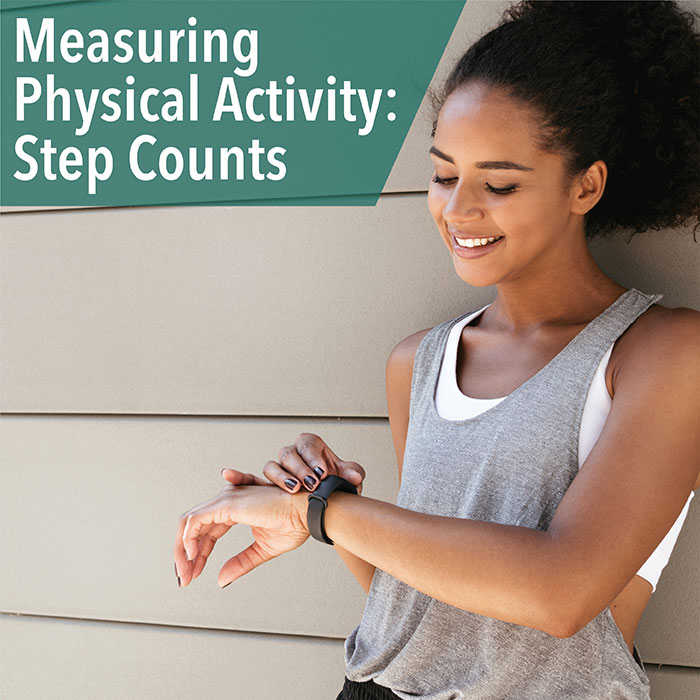Daily Steps and Health | Walking Your Way to Better Health

Walking 10,000 steps a day – what is the correct number? ANSWERED by the Physical Activity Guidelines Advisory Committee.
Being physically active is one of the most important actions people of all ages and fitness levels can take to improve their health. A 2017 survey suggests that more than 75% of U.S. adults acknowledge that “being in shape and looking good are ‘very important,’” yet only 31% of those surveyed exercise regularly and almost half are inactive. Beyond “being in shape and looking good,” exercise and physical activity provide a myriad of health benefits, many of which are easy to achieve.
In November 2018, the Department of Health and Human Services released the second edition of the Physical Activity Guidelines for Americans. Some of the key updates are: an expansion of the list of health benefits associated with physical activity; greater flexibility on how to achieve those benefits; and highlighting the many proven strategies to help people be more active. The key guidelines for adults and older adults have a few main takeaways:
- Adults should move more and sit less throughout the day. Some physical activity is better than none. Adults who sit less and do any amount of moderate-to-vigorous physical activity gain some health benefits.
- For substantial health benefits, adults should do at least 150 minutes to 300 minutes a week of moderate-intensity, or 75 minutes to 150 minutes a week of vigorous-intensity aerobic physical activity, or an equivalent combination of moderate- and vigorous-intensity aerobic activity.
- Additional health benefits are gained by engaging in physical activity beyond the equivalent of 300 minutes of moderate-intensity physical activity a week.
- Adults should also do muscle-strengthening activities of moderate or greater intensity that involve all major muscle groups on 2 or more days a week, as these activities provide additional health benefits.
There are many ways for adults of all ages and fitness levels to achieve these federally recommended amounts of physical activity. However, simplifying the guidelines into something such as daily step counts may be an easy way for the majority of Americans to understand and achieve these guidelines. Step counts provide a straightforward metric of physical activity, and measuring daily step counts through a physical activity tracker is an easy and accessible way to monitor and set physical activity goals. In many health and fitness circles, a goal of 10,000 steps/day is often prescribed. In fact, some countries are adopting a 10,000 steps/day target as a national public health goal.1 However, the research supporting the 10,000 steps a day recommendation is limited and many believe this recommendation was derived from the name of a Japanese-made pedometer sold in the 1960s called Manpo-kei, which translates to “10,000 steps meter.2”
Given the simplicity and utility of steps/day as a metric for physical activity, translating the “150 to 300 minutes per week of moderate-to-vigorous physical activity” into a steps/day recommendation is important. As a result, the Physical Activity Guidelines Advisory Committee (PAGAC), who produced the scientific report that informed the development of the physical activity guidelines, systematically reviewed the literature to better understand the relationship between steps/day and health.
The PAGAC results were first published in the 2018 PAGAC Scientific Report but have recently been updated in ACSM’s journal, Medicine & Science in Sports & Exercise. This recent publication, titled Daily Step Counts for Measuring Physical Activity Exposure and Its Relation to Health, identified eleven studies that evaluated the relationship between daily step counts and all-cause mortality, cardiovascular disease morality, incident cardiovascular disease, and type 2 diabetes mellitus. In short, the investigators found that, compared to people who accumulated the least number of steps/day, those who accumulated the most steps/day were less likely to suffer from cardiovascular disease, type 2 diabetes, and experience premature mortality. The authors acknowledge and specify that many research gaps still exist, and that more evidence is needed before these findings can be accurately translated into public health guidelines. However, the investigators suggest that step counts in the range of 7,000 to 9,000 steps/day may result in health benefits that are similar to achieving the federally recommended amounts of 150 to 300 minutes per week of moderate-to-vigorous physical activity.
The physical activity guidelines encourage all adults to move more and sit less throughout the day. Locomotion, specifically walking, is an easy and popular form of physical activity for most Americans4 and can be of moderate-intensity. Worldwide, the average number of steps accrued daily is approximately 5,000. In United States, it is 4,800.3 So, whether it is somewhere in the range of 7,000 to 9,000, 5,000, or 4,801steps/day, let’s keeping walking our way to better health.
Author: Kyle Sprow, MPH is a Cancer Research Training Award Fellow with the National Cancer Institute. He was part of the federal staff that supported the Physical Activity Guidelines Advisory Committee and the development of the second edition of the Physical Activity Guidelines for Americans.
References
- Duncan MJ, Brown WJ, Mummery WK, Vandelanotte C. 10,000 Steps Australia: a community-wide eHealth physical activity promotion programme. Br J Sports Med. 2018;52(14):885–6
- Lee I, Shiroma EJ, Kamada M, Bassett DR, Matthews CE, Buring JE. Association of Step Volume and Intensity With All-Cause Mortality in Older Women. JAMA Intern Med. Published online May 29, 2019. doi:10.1001/jamainternmed.2019.0899
- Althoff T, Sosič R, Hicks JL, King AC, Delp SL, Leskovec J. Large-scale physical activity data reveal worldwide activity inequality. Nature. 2017;547(7663):336-339. doi:10.1038/nature23018
- Watson, K. B., Frederick, G. M., Harris, C. D., Carlson, S. A., & Fulton, J. E. (2015). U.S. Adults’ Participation in Specific Activities: Behavioral Risk Factor Surveillance System–2011. Journal of physical activity & health, 12 Suppl 1(0 1), S3–S10. doi:10.1123/jpah.2013-0521

